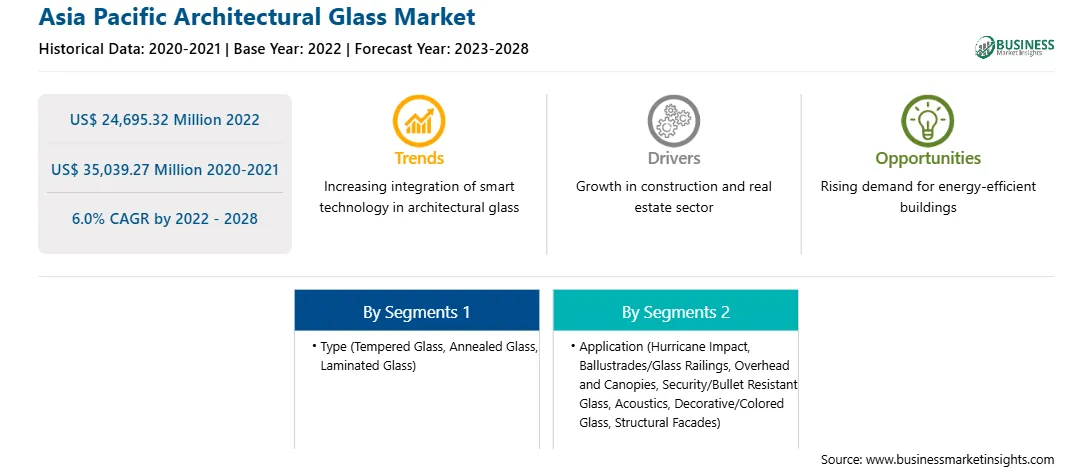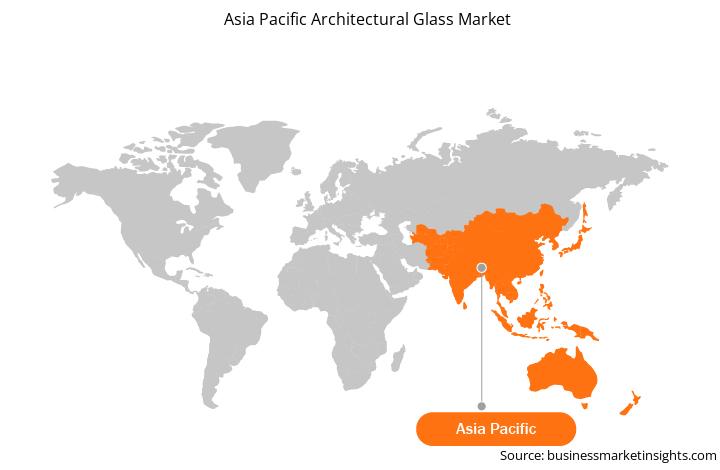Adoption of Growth Strategies by Manufacturers is Expected to Open New Opportunities in The Asia Pacific Architectural Glass Market Over the Forecast Period
The Asia Pacific architectural glass market is growing with an upward trend, and manufacturers are making significant investments in research & development, partnerships, and collaborations to launch innovative products to tap into emerging market opportunities. Market players focus on providing innovative products in response to an ever-increasing demand for architectural glass. For instance, in July 2019, Şişecam launched its new product, Şişecam Extra Strong Laminated Glass, with improved security performance level. It combines two or more glass panels with a more robust and durable special binding agency extra stiff polyvinyl butyral (PVB) interlayer under heat and pressure. The company hopes to gain a stronghold on the market with this launch. Such product launches are expected to drive the market in the coming years. Furthermore, architectural glass manufacturers are expanding their businesses through collaboration, mergers & acquisitions, and expansion strategies. For instance, in October 2020, AGC Inc. completed the business integration of the Architectural Glass Business in Japan with Central Glass Co. Ltd by the fiscal year ending December 31, 2021, in the fourth quarter. Moreover, manufacturers are investing in new technologies for glass production to cater to customers' requirements for good quality glass. Such strategic initiatives aim to offer greater availability of value-added products. Such strategic initiatives are expected to open new opportunities in the Asia Pacific architectural glass market over the forecast period.
Asia Pacific Architectural Glass Market Overview
The major countries in Asia Pacific include India, China, Japan, South Korea, and Australia. The per capita income in Asia Pacific has increased, along with the development of affordable residential activities. Hence, Asia Pacific is witnessing rapid urbanization and a surge in the construction projects of residential and commercial buildings. The beneficial government policies related to residential properties in several developing countries of the region have propelled urbanization. For instance, according to the report by the Department for Promotion of Industry and Internal Trade (DPIIT), the government of India has planned to boost the infrastructure and construction services through several policies such as open FDI norms, large budget allocation to the infrastructure sector, smart cities mission, etc. The report also stated that the real estate industry in India is projected to reach US$ 1 trillion by 2030, along with an increased year-on-year infrastructure Capex by 34% to reach US$ 6.7 million. Thus, the consequent growth of the construction industry in developed countries is fueling the demand for architectural glass in the region. Moreover, the rise in awareness regarding energy-efficient glass for construction applications and new developments in the solar industry are expected to boost the demand for the glass in the coming years. The photovoltaic (PV) modules used in the solar applications are incorporated with architectural laminated glass cover plates. Therefore, the growing expansion of the real estate industry, rising investments in the construction sector, and rise in sustainable construction in the region are anticipated to boost the demand for architectural glass during the forecast period.
Strategic insights for the Asia Pacific Architectural Glass provides data-driven analysis of the industry landscape, including current trends, key players, and regional nuances. These insights offer actionable recommendations, enabling readers to differentiate themselves from competitors by identifying untapped segments or developing unique value propositions. Leveraging data analytics, these insights help industry players anticipate the market shifts, whether investors, manufacturers, or other stakeholders. A future-oriented perspective is essential, helping stakeholders anticipate market shifts and position themselves for long-term success in this dynamic region. Ultimately, effective strategic insights empower readers to make informed decisions that drive profitability and achieve their business objectives within the market. The geographic scope of the Asia Pacific Architectural Glass refers to the specific areas in which a business operates and competes. Understanding local distinctions, such as diverse consumer preferences (e.g., demand for specific plug types or battery backup durations), varying economic conditions, and regulatory environments, is crucial for tailoring strategies to specific markets. Businesses can expand their reach by identifying underserved areas or adapting their offerings to meet local demands. A clear market focus allows for more effective resource allocation, targeted marketing campaigns, and better positioning against local competitors, ultimately driving growth in those targeted areas.
Asia Pacific Architectural Glass Strategic Insights

Asia Pacific Architectural Glass Report Scope
Report Attribute
Details
Market size in 2022
US$ 24,695.32 Million
Market Size by 2028
US$ 35,039.27 Million
Global CAGR (2022 - 2028)
6.0%
Historical Data
2020-2021
Forecast period
2023-2028
Segments Covered
By Type
By Application
Regions and Countries Covered
Asia-Pacific
Market leaders and key company profiles
Asia Pacific Architectural Glass Regional Insights

Asia Pacific Architectural Glass Market Segmentation
The Asia Pacific architectural glass market is segmented into type, application, and country.
Based on type, the Asia Pacific architectural glass market is segmented into tempered glass, annealed glass, laminated glass, and others. In 2022, the laminated glass segment registered a largest share in the Asia Pacific architectural glass market.
Based on application, the Asia Pacific architectural glass market is segmented into hurricane impact, ballustrades/glass railings, overhead and canopies, security/bullet resistant glass, acoustics, decorative/colored glass, structural facades, and others. In 2022, the structural facades segment registered a largest share in the Asia Pacific architectural glass market.
Based on country, the Asia Pacific architectural glass market is segmented into Australia, China, India, Japan, South Korea, and the Rest of Asia Pacific. In 2022, China segment registered a largest share in the Asia Pacific architectural glass market.
AGC Inc; Asahi India Glass Ltd; Compagnie de Saint-Gobain SA; Guardian Industries Holdings LLC; Jinjing (Group) Co Ltd, Nippon Sheet Glass Co Ltd; Qingdao Morn Building Materials Co Ltd; Schott AG; Turkiye Sise ve Cam Fabrikalari AS; and Vitro SAB de CV are the leading companies operating in the Asia Pacific architectural glass market.
The Asia Pacific Architectural Glass Market is valued at US$ 24,695.32 Million in 2022, it is projected to reach US$ 35,039.27 Million by 2028.
As per our report Asia Pacific Architectural Glass Market, the market size is valued at US$ 24,695.32 Million in 2022, projecting it to reach US$ 35,039.27 Million by 2028. This translates to a CAGR of approximately 6.0% during the forecast period.
The Asia Pacific Architectural Glass Market report typically cover these key segments-
The historic period, base year, and forecast period can vary slightly depending on the specific market research report. However, for the Asia Pacific Architectural Glass Market report:
The Asia Pacific Architectural Glass Market is populated by several key players, each contributing to its growth and innovation. Some of the major players include:
The Asia Pacific Architectural Glass Market report is valuable for diverse stakeholders, including:
Essentially, anyone involved in or considering involvement in the Asia Pacific Architectural Glass Market value chain can benefit from the information contained in a comprehensive market report.